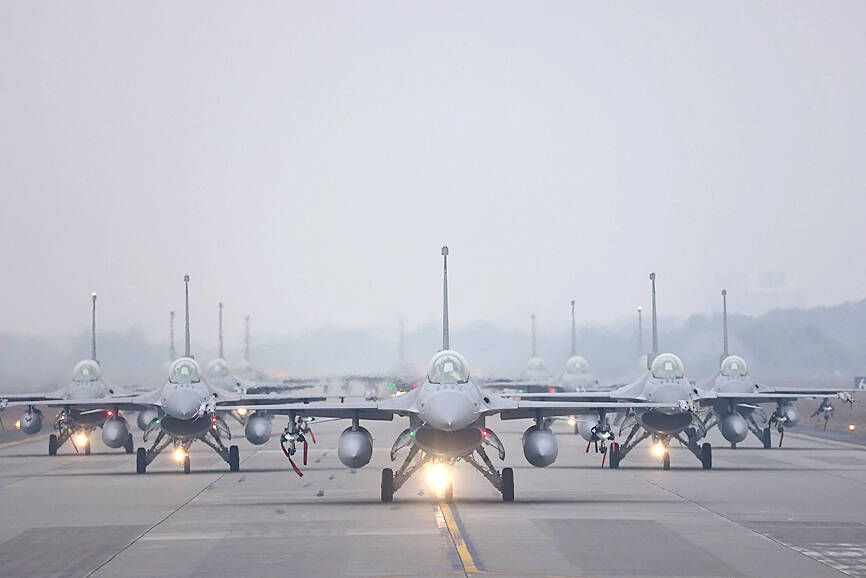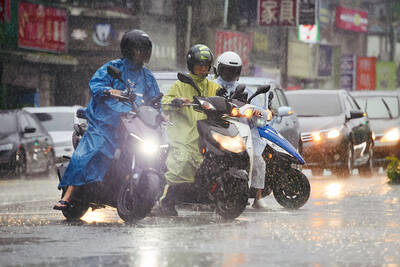The backlog of US arms sales to Taiwan is worth US$19.17 billion, with F-16s and Abrams tanks making up more than 50 percent of the value, the Cato Institute said in a study published on Monday.
The study drew data from the US Department of Defense’s Defense Security Cooperation Agency and the Stockholm International Peace Research Institute.
Washington has not released detailed information on delayed arms shipments.

Photo: Ann Wang, Reuters
The Cato Institute broke down the arms backlog into “traditional,” “asymmetric” and “munition” weapons categories and capabilities, with traditional being 63.2 percent of the total, asymmetric comprising 22 percent and munitions 14.8 percent, the study said.
The undelivered traditional capabilities, totaling US$12.113 billion, mainly consisted of US$8 billion of F-16C/D Block 70 jets and US$2 billion of M1A2T Abrams tanks, it said.
The undelivered traditional capabilities also included M109A6 Paladin self-propelled howitzers comprising 3.9 percent of the total backlog, while infrared search and track systems for F-16s comprised 2.6 percent and MK 15 Phalanx close-in weapon systems comprised 2.2 percent, it said.
The traditional capabilities delayed also included MS-110 jet reconnaissance pods (1.9 percent) and AN/SLQ-32 electronic warfare systems for Keelung-class destroyers (0.4 percent), the study said.
However, the backlogged traditional systems would have imposed a high cost on Taiwan’s limited defense resources and would be of “minimal utility” in fighting the Chinese the People’s Liberation Army, it said.
The US should prioritize the delivery of asymmetric capabilities and ammunition “to keep Taipei from running out of reloads quickly in a conflict,” the study said.
The asymmetric capabilities, worth US$4.221 billion, included Harpoon coastal defense systems totaling US$2.37 billion, or 12.4 percent of the backlog, it said.
The undelivered asymmetric capabilities also included MQ-9B uncrewed aerial vehicles comprising 3.1 percent of the backlog and High Mobility Artillery Rocket Systems comprising 2.3 percent, it said.
Air-launched Harpoon missiles comprised 1.9 percent of the backlog, Field Information Communication Systems comprised 1.5 percent and Volcano anti-tank mining systems comprised 0.9 percent, it added.
Munitions not yet delivered totaled US$2.835 billion, including AGM-84H SLAM-ER missiles worth US$1.008 billion, or 5.3 percent of the backlog, as well as F-16 munitions comprising 3.2 percent, it said.
In addition, MK 48 heavyweight torpedoes, 30mm rounds, AGM-154C Joint Standoff Weapons, lightweight torpedoes and conversion kits, and AIM-9X Block II missiles accounted for 2.2 percent, 2.2 percent, 1.7 percent, 1 percent, 0.9 percent and 0.4 percent of the backlog respectively, the study said.

The combined effect of the monsoon, the outer rim of Typhoon Fengshen and a low-pressure system is expected to bring significant rainfall this week to various parts of the nation, the Central Weather Administration (CWA) said. The heaviest rain is expected to occur today and tomorrow, with torrential rain expected in Keelung’s north coast, Yilan and the mountainous regions of Taipei and New Taipei City, the CWA said. Rivers could rise rapidly, and residents should stay away from riverbanks and avoid going to the mountains or engaging in water activities, it said. Scattered showers are expected today in central and

People can preregister to receive their NT$10,000 (US$325) cash distributed from the central government on Nov. 5 after President William Lai (賴清德) yesterday signed the Special Budget for Strengthening Economic, Social and National Security Resilience, the Executive Yuan told a news conference last night. The special budget, passed by the Legislative Yuan on Friday last week with a cash handout budget of NT$236 billion, was officially submitted to the Executive Yuan and the Presidential Office yesterday afternoon. People can register through the official Web site at https://10000.gov.tw to have the funds deposited into their bank accounts, withdraw the funds at automated teller

COOPERATION: Taiwan is aligning closely with US strategic objectives on various matters, including China’s rare earths restrictions, the Ministry of Foreign Affairs said Taiwan could deal with China’s tightened export controls on rare earth metals by turning to “urban mining,” a researcher said yesterday. Rare earth metals, which are used in semiconductors and other electronic components, could be recovered from industrial or electronic waste to reduce reliance on imports, National Cheng Kung University Department of Resources Engineering professor Lee Cheng-han (李政翰) said. Despite their name, rare earth elements are not actually rare — their abundance in the Earth’s crust is relatively high, but they are dispersed, making extraction and refining energy-intensive and environmentally damaging, he said, adding that many countries have opted to

CONCESSION: A Shin Kong official said that the firm was ‘willing to contribute’ to the nation, as the move would enable Nvidia Crop to build its headquarters in Taiwan Shin Kong Life Insurance Co (新光人壽) yesterday said it would relinquish land-use rights, or known as surface rights, for two plots in Taipei’s Beitou District (北投), paving the way for Nvidia Corp to expand its office footprint in Taiwan. The insurer said it made the decision “in the interest of the nation’s greater good” and would not seek compensation from taxpayers for potential future losses, calling the move a gesture to resolve a months-long impasse among the insurer, the Taipei City Government and the US chip giant. “The decision was made on the condition that the Taipei City Government reimburses the related